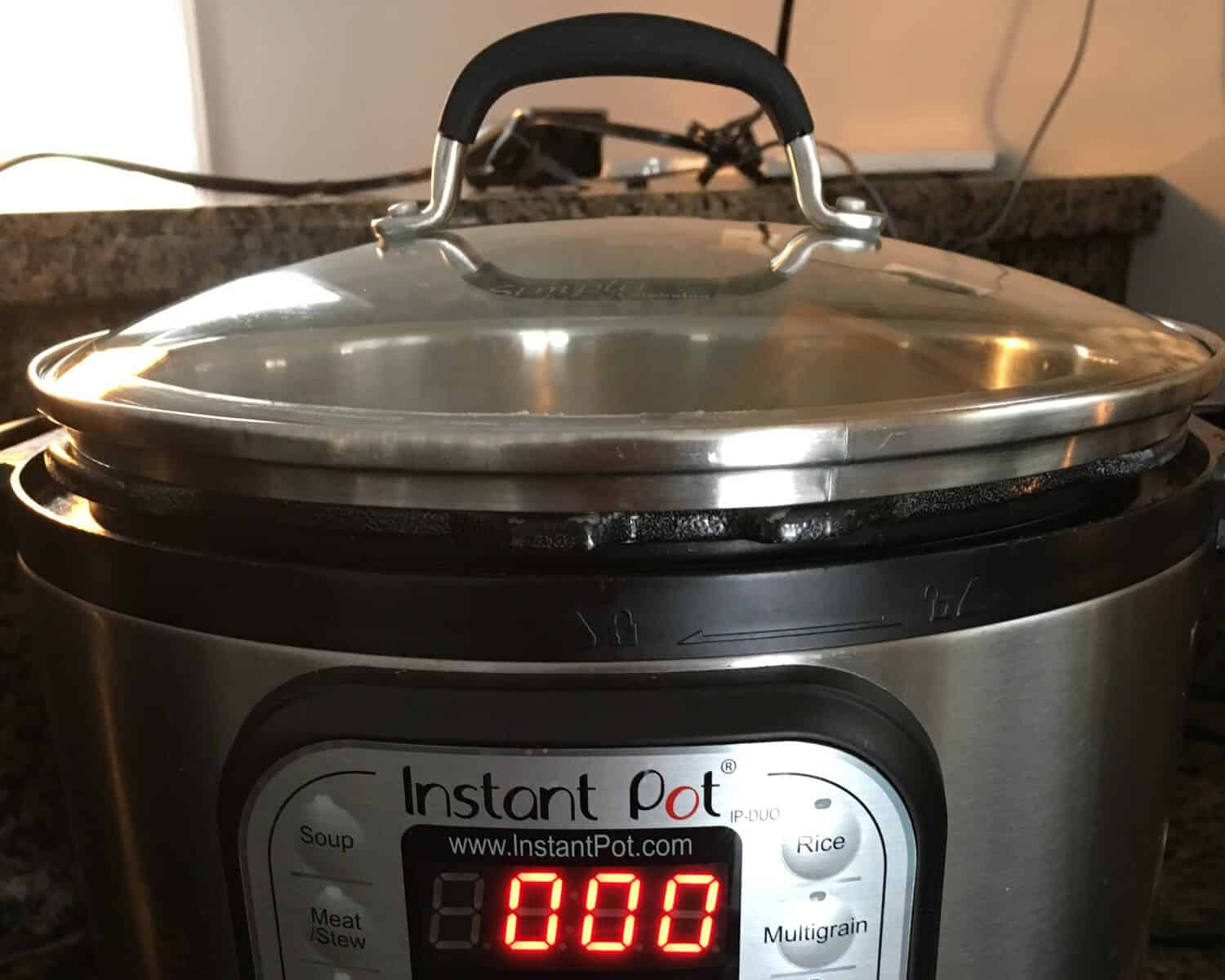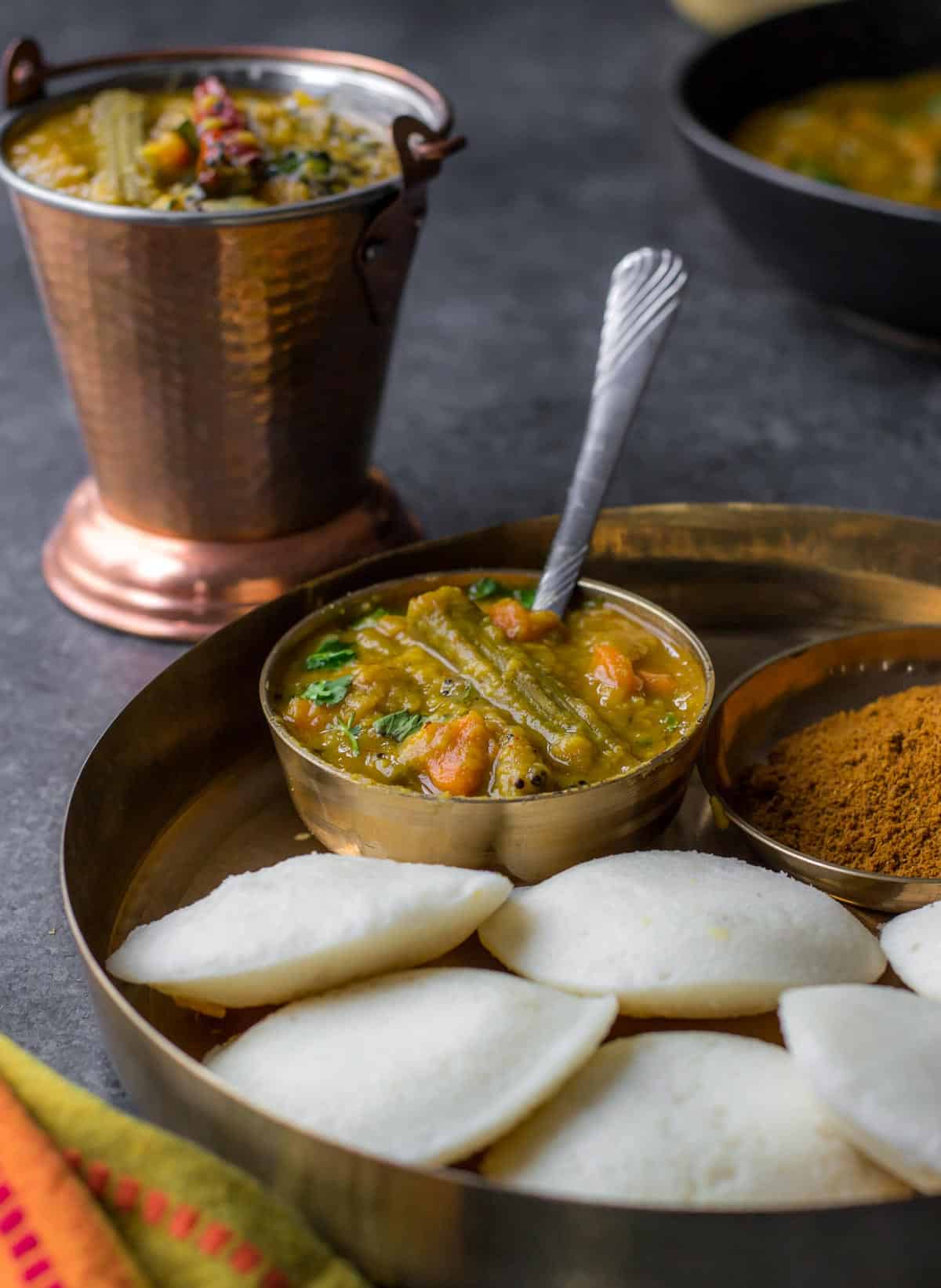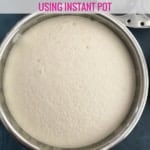Fast Pot idli recipe – Do you struggle with idli batter not fermenting in winter? Learn tips on how to ferment idli/dosa batter and steam the proper soft and fluffy idlis in an Fast Pot.

What’s idli?
‘Idli’ (or ‘Idly’ if you happen to’re so inclined) is a mildly flavored, barely tangy steamed rice cake that melts in your mouth when paired with a bowl of fragrant sambar and nutty coconut chutney.
This iconic breakfast dish from South India is popular not only in its homeland but in addition in Indian restaurants across continents.
What makes crafting the proper idli tricky?
The recipe to make idlis calls for just a few easy steps:
- Soak rice and urad dal individually, grind them to perfection, and whisk to mix.
- Let the batter rest for not less than 8-10 hours, and let nature work its fermentation magic.
- Once fermented, scoop the batter into idli molds and steam to create those spongy wonders.
Sounds straightforward, right?
Nevertheless, the trail to idli nirvana can sometimes be fraught with pitfalls, especially when the fickle fermentation process comes into play. Get it right, and also you’re rewarded with cloud-like, fluffy, and spongy idlis. Miss the mark (which frequently happens during cold winters), and you would possibly find yourself with a batch of hard, flat duds.
Fear not! For I’ve discovered the game-changer: The Fast Pot.
This marvel not only ensures consistent fermentation but in addition doubles up as a stellar steaming device, ensuring your idlis are on point each time.
Able to let the Fast Pot revolutionize your idli game? Let’s begin by gathering the ingredients and tools.

- Fast Pot pressure cooker – Whether it’s the 6-quart or the more spacious 8-quart version, each versions of this electric pressure cooker work wonders for making idlis.
- Glass lid – Use this to cover the Fast Pot while fermenting as a substitute of using the lid that comes with it.
- Idli stand – This idli stand is ideal for the 6-quart Fast Pot.
A very good blender is essential to getting the idli dosa batter to the best consistency. Listed below are those I like to recommend.
- Electric Wet stone grinder – This grinder definitely does churn out a few of the perfect idlis. The one downside? The 20-30 minute grinding time. But, trust me, it’s well worth the wait.
- Indian Mixer and Grinder – A household device in lots of Indian homes. Be careful for overheating – use cold water and grind in small batches to guard the batter’s useful bacteria.
- High-performance blenders like Blendtec – My personal favorite! The smoothie cycle is ideal for grinding urad dal and rice. Again, use cold water to grind to sidestep issues with the batter getting warm during mixing.
Don’t have an Fast Pot? Take a look at this post – tips on how to make idlis using an idly cooker. It’s an in depth guide that lays out the idli-making process and provides different options to grind and ferment the proper homemade idli dosa batter.
The three steps to creating soft idlis in Fast Pot
Now you may have the ingredients found out and prepared together with your Fast Pot, let’s dive into the step-by-step guide to creating the proper idlis right at home.
Step 1 – Soak and grind
Soaking: Kickstart your idli-making process by soaking rice (together with fenugreek seeds) and urad dal in separate bowls stuffed with ample water. Allow them to soak for about 4-6 hours. This step is important because it softens the grains and preps them for grinding.
Grinding: Once the soaking phase is finished, drain the water and grind the urad dal right into a silky-smooth paste. Remember so as to add water sparingly. Next, grind the rice, aiming for a rather coarse texture. Now, add each the pastes to a big bowl. Whisk them along with either clean hands or a spatula, ensuring a consistency just like pancake batter.
Step 2 – Fermenting the batter in Fast Pot
Listed below are the steps to follow to ferment the batter within the Fast Pot
- Yogurt Setting: In your Fast Pot, select the ‘Yogurt’ function. Set it to ‘Less’ mode, timing it for 14 hours in winter and 12 hours in summer.
- Temperature Regulation: Pour the batter into the inner pot. Add ice cubes to the batter. This system regulates temperature, which is very vital if there’s a risk of overheating.
- Glass Lid Usage: Go for a glass lid as a substitute of the regular Fast Pot lid. This ensures the lid doesn’t jam resulting from the rising fermented batter.
- “More” mode: Ideal for pasteurizing milk: 71~83°C (160~180°F).
- “Normal” mode: Perfect for making homemade yogurt: 36 ~ 43° C (96.8 ~ 109.4°F);
- “Less” mode: for making Jiu Niang (fermented glutinous rice): 30 ~ 34°C (86 ~ 93.2°F). Interestingly, this mode also aligns with the ideal temperature for idli batter fermentation, which is 75 – 90°F. So, if you happen to’re venturing into making idli batter, at all times select the “Less” mode. Selecting another mode might result in a batter that finally ends up being cooked fairly than fermented.

Step 3 – Steam idlis in Fast Pot
1. Set to Steam: Select the ‘Steam’ function in your Fast Pot.
2. Keep the vent open: That is crucial! All the time keep the vent open. It replicates the steaming process just like the traditional idli cooker.
3. Use an external timer: Here’s an Fast Pot nuance. With the vent open during ‘Steam’ mode, the built-in timer won’t operate. But a fast fix is to set an external timer for 10 minutes.
4. Steam away: Pour your idli batter into the molds and place them within the Fast Pot. With the high-pressure steam function, 9-10 minutes is all it takes for those idlis to return out beautifully soft and fluffy.

Suggestions for making soft idlis
If you may have been attempting to create the softest, fluffiest idlis, your search ends here. While the standard method has its charm, the fashionable Fast Pot brings efficiency, ensuring perfect results each time. Listed below are the secrets to achieving idli perfection:
1. Rice Selection:
The cornerstone of each idli recipe. Select idli rice, parboiled rice, or ponni boiled rice for best results.
2. Rice-to-Urad dal Ratio:
- Summer: Persist with a 1:4 ratio of urad dal to rice.
- Winter: Modify it to a 1:3 ratio, upping the urad dal content to assist fermentation.
3. Grinding Strategy:
- All the time grind with cold water. It keeps the batter’s temperature in check, especially if the blender heats up.
- Grind the rice and urad dal individually. The urad dal ought to be a superb, airy paste, while the rice should feel coarse.
4. Batter consistency:
Your batter should resemble a free-flowing pancake batter – not too thin and definitely not too thick.
5. Whisking the Batter:
That is the step where magic happens. Whether you employ your hands, a spatula, or a whisk, make sure the rice and urad dal batters mix perfectly while aerating the mixture.
6. Salting:
Especially in cold conditions, add salt post-fermentation. Table salt accommodates iodine can potentially decelerate the fermentation process. Note: it’s okay so as to add non-iodized salts corresponding to rock salt or Himalayan salt to the batter before fermentation.
7. Discover a warm place:
Whether it’s an oven, heat vent, or Fast Pot, find what works best for you.
8. Grease the molds:
Make sure you grease the idli molds well in order that idlis slide off easily.
9. Watch the Clock:
Overcooked idlis result in hard idlis. Most idli makers, including the Fast Pot, could have your idlis ready in under 10 minutes.
10. Batter Temperature:
Should you’re retrieving batter from the fridge, allow it to achieve room temperature before steaming to forestall flat idlis.
Fast Pot-Specific Suggestions:
1. Ice-cube trick:
Add ice cubes to your batter to control the temperature, especially to counter any overheating.

2. Select the best lid:
Swap out the regular Fast Pot lid for a glass lid. This move ensures your lid stays jam-free as your batter rises.

3. Use the ‘Less’ setting:
For idli batter fermentation, maintain a temperature between 75 – 90°F. When using your Fast Pot, make sure the mode is ready to ‘Less’. Every other mode risks overcooking the batter.
4. Use an external timer:
With the vent open during ‘Steam’ mode, the built-in timer won’t operate. Ensure that to make use of an external timer.
I’m sure with the following pointers your idli-making endeavors will reach latest heights. Dive into the method and let those fluffy idlis steal the show at your next meal!

Storage instructions
Storing leftover idlis
Leftover idlis stay good within the refrigerator for 2-3 days. You may at all times turn them into this delicious idli-fry.
Storing leftover idli batter
Listed below are some handy recommendations on storing idli batter. Proper storage may also help maintain the batter’s freshness, allowing you to enjoy delicious idlis, crispy dosas, and uttapams at any time.
1. Refrigeration:
Refrigerating helps delay the lifetime of the batter by slowing down the fermentation process, stopping the batter from turning sour too rapidly. Typically, refrigerated batter stays fresh for about per week. Just ensure your container is airtight.
2. Freezing:
For those seeking to store their idli batter for a more prolonged period, the freezer involves the rescue. You may freeze your batter for as much as a month. A couple of things to notice:
- Make sure the batter is stored in a freezer-safe container to avoid freezer burn.
- Once you’re able to use the frozen batter, remember to thaw it completely.
- While you possibly can still make idlis with thawed batter, they won’t be as fluffy as usual. So, the thawed batter is best fitted to making crispy dosas or flavorful uttapams.
Instructions for Use:
No matter where you store your batter, before you dive into the idli-making process, be certain that to bring the batter to room temperature. Using cold batter directly from the fridge or after thawing can lead to flat idlis.

Other breakfast recipes value trying out
Should you are on the lookout for Indian breakfast recipes, listed below are just a few of my go-to recipes

Fast Pot Steamed Idli (Savory Rice Cakes) Recipe
Learn tips on how to make soft and fluffy idlis, a beloved South Indian breakfast dish, using your Fast Pot. Discover suggestions and tricks for creating a wonderfully fermented batter and steaming it to perfection.
Pin Print Save Email- 2 cups idli rice / parboiled rice or ponni rice
- ½ cup Urad gota (whole urad) or urad dal
- 1 teaspoon methi seeds fenugreek seeds
- ½ cup thick poha flattened rice (optional)
- 1 teaspoon salt
- cold water as needed
Prevent your screen from going dark
Soaking
Begin by rinsing the rice and urad dal individually until the water runs clear.
Add the methi/fenugreek seeds to the rice and immerse in water for 4-6 hours.
Soak the urad dal too, for a similar duration but in a separate bowl.
Grinding
Should you’re using thick poha (flattened rice), soak a fistful of it in water for about 5 minutes.
While the poha is soaking, drain the urad dal and grind it right into a smooth paste, adding water a tablespoon at a time. You will need about 3/4 cup in total.
Transfer this paste to the steel insert of your Fast Pot.
Now, grind the rice and the soaked poha to a rough consistency using roughly 1 cup of cold water.
Add the rice paste to the Fast Pot on top of the urad dal paste and whisk them well.
Mix this rice paste with the urad dal paste within the Fast Pot. Add extra water (around 1/2 cup) to attain a batter that is neither too thick nor too runny almost pancake-like batter.
Fermentation
Put the steel insert contained in the Fast Pot and choose the ‘Yogurt’ function. Ensure that it reads “YOGT” and adjust to the ‘Less’ setting. Set the time: 12 hours for summer and as much as 15 hours for colder days.
Add 5-6 ice cubes to the combo and use a glass lid to cover the pot (not the usual Fast Pot lid).
Once the batter doubles up, add salt and stir the batter thoroughly.
Transfer the fermented idli batter from the steel insert to a different container. Clean the steel insert well and place it back within the Fast Pot.
Steaming
Grease your idli molds. Pour the batter, filling them to three/4th capability to go away room for rising. Remember, don’t fill the bottom rack of the mold since the idlis are likely to get soggy resulting from close proximity to the water within the inner pot.
Pour 1 cup of water into your Fast Pot and set to the ‘Saute’ function. Once the water involves a boil, hit cancel, place the idli stand inside, and shut the lid.
Select the ‘Steam’ function and adjust the pressure to high. Keep the vent open and use an external timer and set the timer for 10 minutes.
Once the time is up, hit cancel. There’ll still be some residual steam so let the Fast Pot cool down for 5-10 minutes before opening the lid.
Rigorously lift the lid, ensuring no droplets fall on the idlis.
Take the idli stand out. Insert a toothpick into an idli. If it comes out clean, your idlis are ready.
Serve these fluffy idlis with sambar and chutneys of your selection.
Disclaimer: Approximate dietary information is provided as a courtesy and might vary depending on the precise ingredients/brands used. If you may have health issues, please work with a registered dietician or nutritionist.
Serving: 1idliCalories: 52kcalCarbohydrates: 11gProtein: 1gSodium: 74mgFiber: 1g
Eating regimen: Gluten-free, Nut-free, Vegan
Course: Breakfast
Method: Fast Pot
Cuisine: Indian





